
Below are the three parametric vessels I created. Each vessel had a unique creative catalyst and different design and fabrication challenges. Universally I focused on one primary transformation for each vessel. Two of the three vessels had a design plan while the last design was discovered. I created an hour glass vase, snake vase, and squid vase. Some of my design and fabrication processes were consistent across all three vessels. A description of my general process is detailed below, followed by a more in-depth description of each vase and some of the print failures. This post concludes with my reflections on parametric design.
I began by designing one print and then prepping the 3d printer. The printer I am using has sat unused for over a year and need some maintenance in order to get printing. I needed to re-square the printing arms, change the filament, level the bed, and fix the bearing that feeds the PLA into the nozzle. The old filament required taking the printer apart and trimming the tube that encases the PLA. After I began printing it become evident that the bearing the feeds the filament into the printer was not grabbing the filament. Repositioning the gear and tightening come screws fixed this problem.


Hourglass Vase

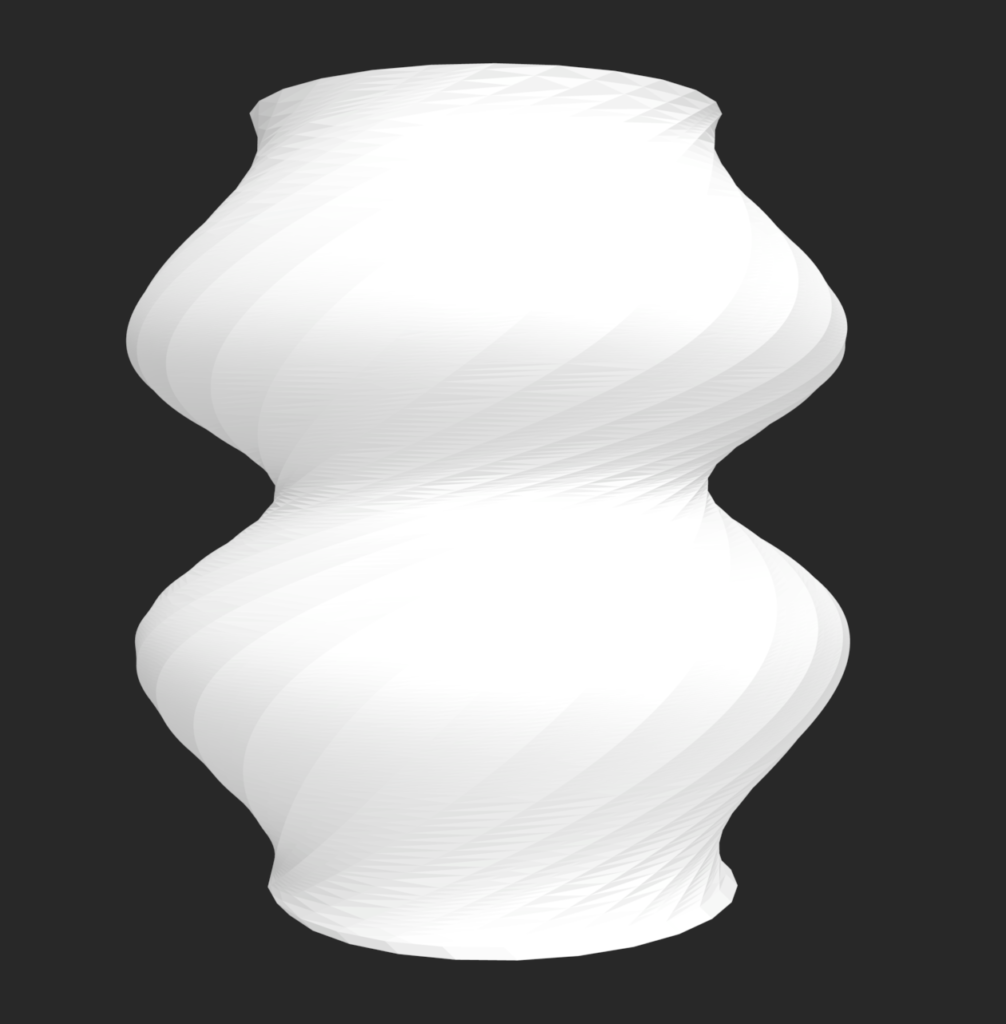
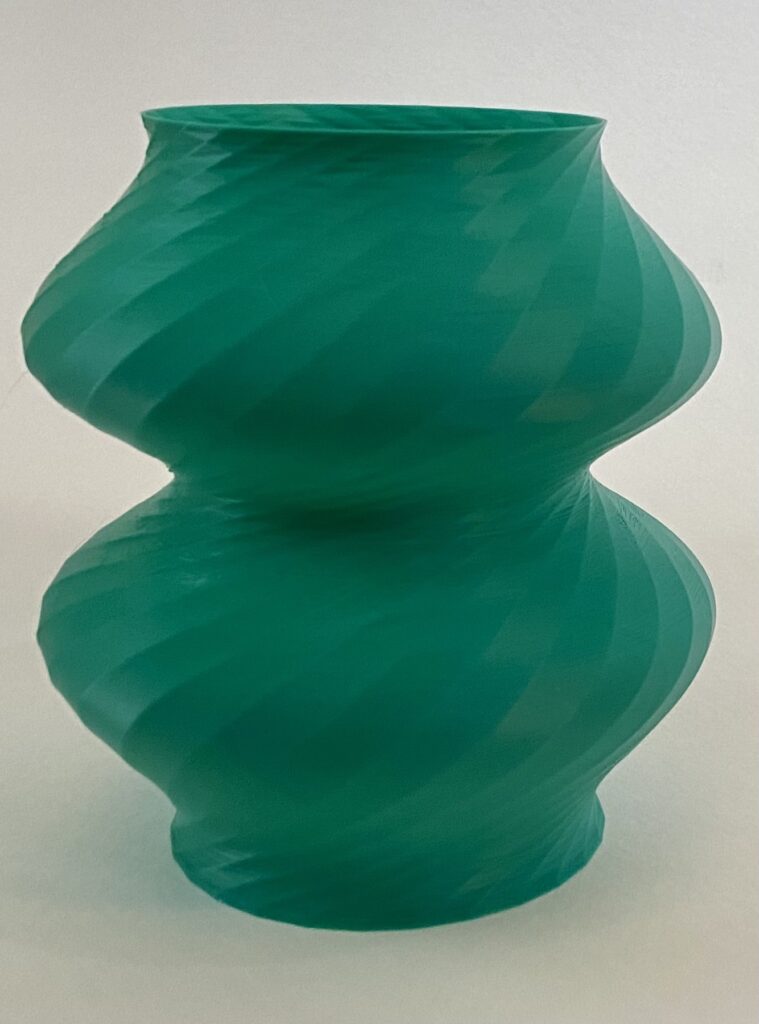
I have recently been looking a different vases and I love those with a small neck and a bulbous belly. I began trying to achieve this shape with a twist transformation. I wanted to start printing with a straight forward classic shape to ensure I had grasp on printing. I wanted a dramatic angle but picked one too quickly. My first design you can see rendered in rhino below and the failure in the failed print section. I redesigned my shape and started the two less dramatic shapes. My print was not prefect and some spots that almost failed. The PLA is thin on the underside of vase’s curves.


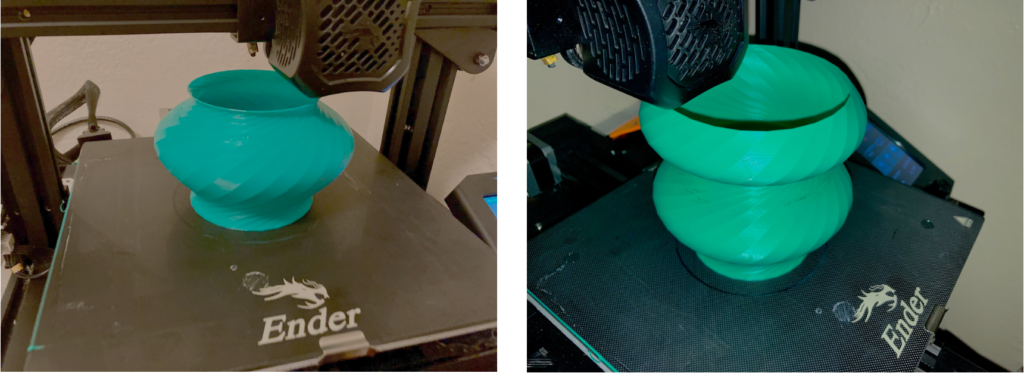
Snake Vase


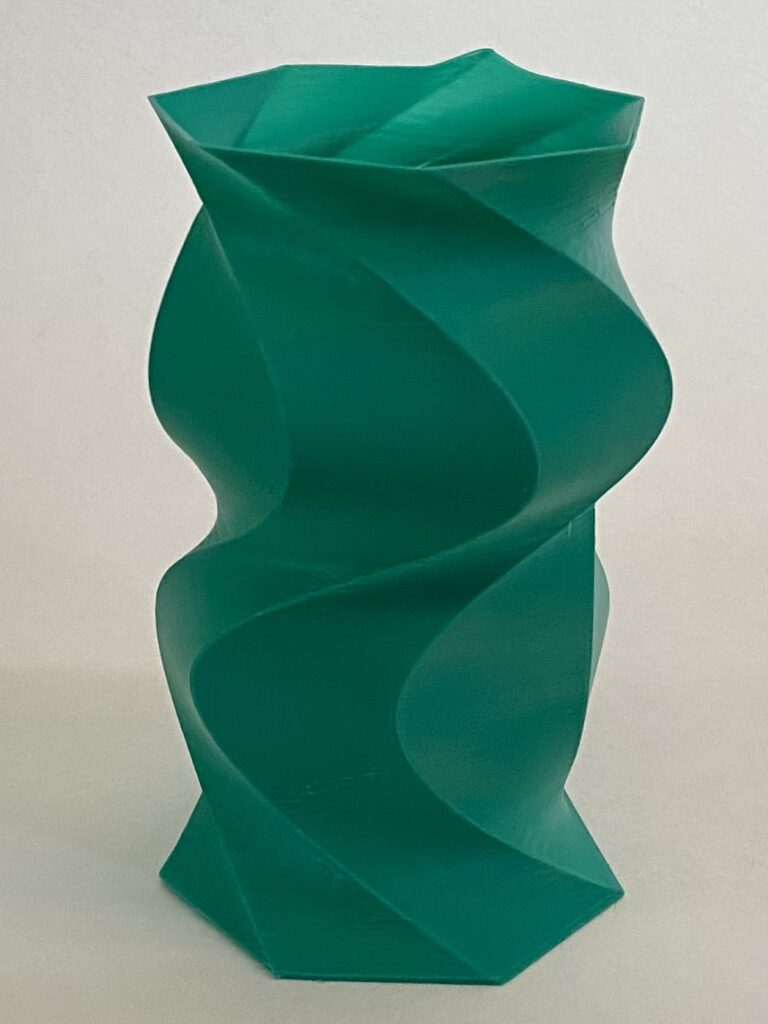
For this vase I wanted to use the roll function to try a fabricate a shape close to viking swung vase. I focused of trying to toll the top polygon shape but was not happy with any of the shapes that I was generating.

I pivoted to different shape. I only liked the long neck that I had made thus far so I ended up designing the first iteration of the snake vase. I loved the shape but I was fairly certain that it would fail. In the end it unsurprisingly failed and was too small for the class requirements. I do want to got back and tweak this vessel to get it to a printable shape.
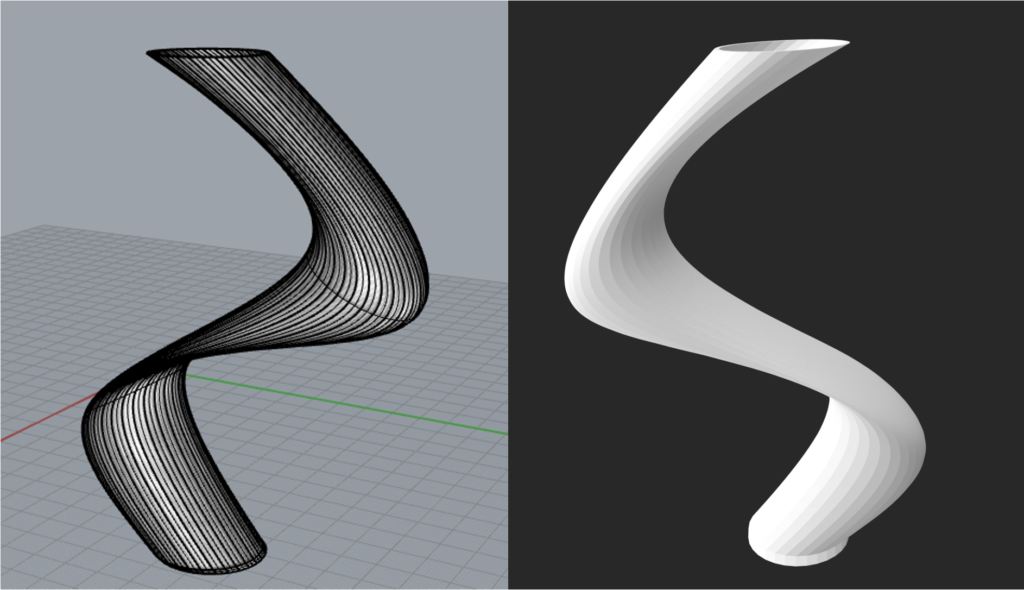
My final vase still has elements from the first vase I loved so much but is printable. I added a twist transformation to the roll transformation. I like that the waves in the vase are the original shape and the vase over all has a more subtle version of the vase.

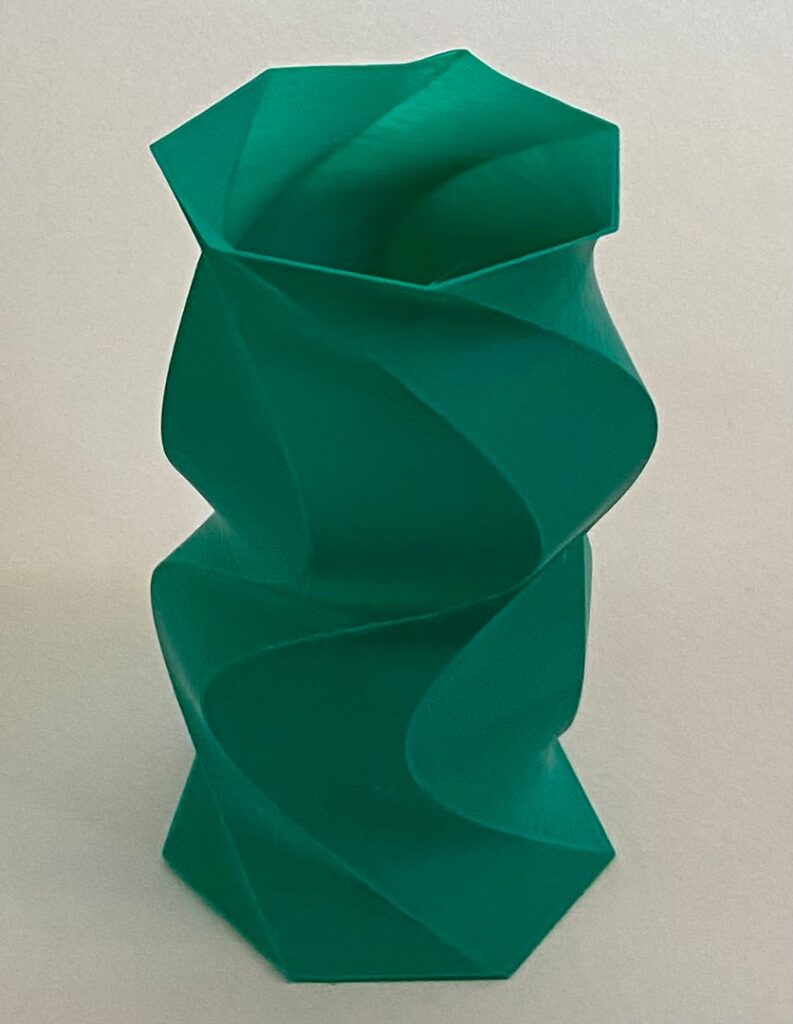
Printing went very smoothly. I decided to print my last two vases at the same time. I was worried about the time remaining after creating a lot of rejected designs and two print failures. I was a bit worried that the prints would have a lot of stings connecting them but the prints were successful.

Squid Vase
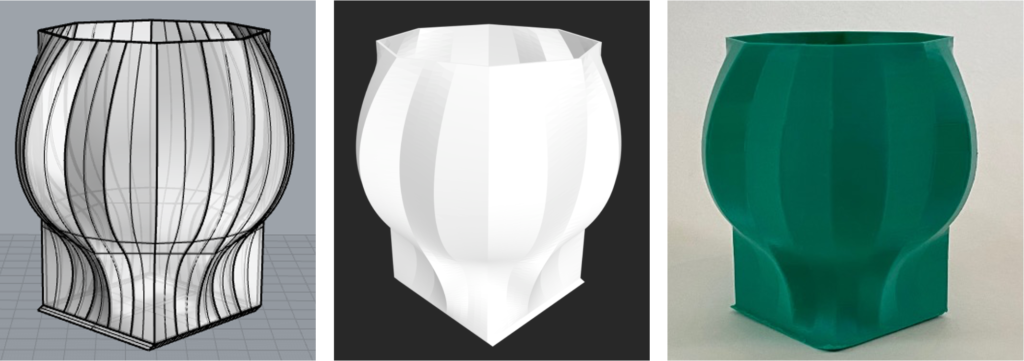
For my final vase I had already played with twist, roll, and yaw transformations. I was not happy with any of the shapes I made trying to rotate around the y axis so I decided to have a different polygon at each layer. From there I played around. I was getting some odd shaped one of which had holes. I was intrigued and thought that maybe the holes would be odd and ugly in a satisfying way. I did not want to gamble so closed the holes and printed my final shape. I did get talked into printing the version with holes, which is also featured in the failed print section.
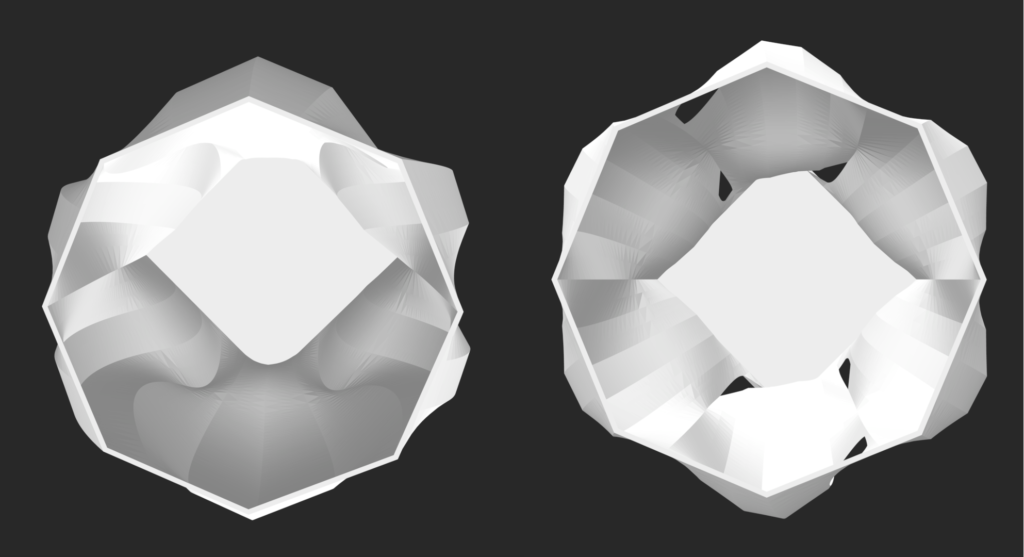
Form this vase I will look at the g code in my slicer software. The Rhino rendering and str file looked interesting but the g-code was a mess…just like the final product.


Failed Prints

Parametric Design
Parametric Design enforces having a strong foundational design. After making three vessels I found that after I had a strong basic shape I could morph, twist, yaw, and roll and it into some beautiful and very different shapes. Designing parametrically allows you to design precisely and create things from base units. For me that means I can create things that otherwise would be trapped inside my mind. I was reminded of a painting class that I took where the teacher had us identify all the basic shapes in the drawing we were trying to replicate and sketch those in first. Then we could come in and add details that made the painting take fruition. Additionally parametric design allows for different technical phenomenons to take visual form. I have loved seeing art inspired by math, nature, and physics. Simply seeing times tables in a beautiful mandala or as a parameter for vase shapes is something personally profound. Paramedic design bridges between things that are more deductive and algorithmic to things that are more typically artistic and crafty.
I tend to be a more chaotic designer. I like to throw things at the wall to see what sticks. I have recently been trying to design with more intention. I think for the first two of my vases I was trying to recreate shapes that have already been designed. So for those vases I feel like it was an exercise in learning how to create paramedic designs well. I made the forms but they were not authored by me. My goal with the first vessel was to create a classic vase and test the limits of my printer. My second vase continued to copy shapes I knew but in failing to do so I discovered the snake shape. Crafting a shape that I loved intentionally makes this shape an artifact I designed. The lack of personal inspiration makes the artifact I am creating feel like artistic plagiarism. For my last shape I was starting to feel agitated as most of the shapes I was creating were shapes I had seen before. In changing the shapes of the polygons I started to see more interesting shapes. The squid shape instantly sparked a world in my mind. The vessel felt like it would fit in a sci-fi world with squid humanoid aliens or something Captain Nemo might own. The inspiration an artifact comes from or creates is the requirement for it to feel like something I authored. The squid vase elicited emotions of discomfort in the form with holes, the final form told a story, and finally the parameters of this vase inspired me to create a set of vessels inspired by times table mandalas.
My sense of authorship does feel different than more traditional disciplines because I feel more adept with code than I do with painting or sculpting. I love to dable in watercolor but I never think of them as something I authored or special. Where in this process I feel like my expertise provides me the confidence that what I have created is of good quality and beautiful. My watercolor is more like a journal I just put whatever on the pages. I put thought, skill, and editing into my parametric designs.
Hello Erin! First off I especially love your design of the snake vase version 1 with the dramatic curves. How did you print two vases at once? Did you load two files into Cura or did you export two vases at the same time? Also it’s surprising to me that you feel less authorship over your watercolor/traditional disciplines than the parametric vessels. Although I guess it shouldn’t because intention played a huge role in why I felt authorship over my designs as well.
I did it Cura by loading two different files. After reading your comment it got me thinking again about authorship and it’s a subtle difference between ownership and authorship I think for me, where intention is the differentiating component. I own my paintings but I did not author them. They are original thoughts form me but I just paint sometimes nothing, mostly my dog; there is no inspiration or planed catharsis which personally precludes them from being authored.
Hey Erin, I love the look of that first snake vase, it turned out really cool and I’m glad you were able to print it! I’m not too sure why there are holes in the squid vase, but it still looks awesome! Great Job!
The holes are the geometries of the different polygons I stacked not lining up correctly. I had four polygons and they all were different, I had to experiment to find a shape that was printable. My .stl preview was really crisp in rhino and Cura but a mess in my g-code preview. I thought the holes would print crisply also. In hindsight if I had looked at the code initially I would have saved myself hours of print time. I really should not have attempted the print.
Hey Erin! your exploration of parametric vessels is both captivating and educational. The meticulous detailing of your process from the initial design to the trials of 3D printing, offers a transparent look into the challenges and achievements of working with parametric design. Your reflections on authorship, particularly your personal journey from emulating existing shapes to discovering the unique snake shape, highlight the importance of originality in design.
Best,
Daniel
Hi Erin, I love all your designs, they look incredible. I’m sorry some of them didn’t come out as planned but it’s definitely a learning experience for us. I think all the vessels are unique in their own way. Great job!
Hi Erin!
I love the shape exploration, the forms you came up with are really beautiful. The in-and-out style of the later figures is very compelling.